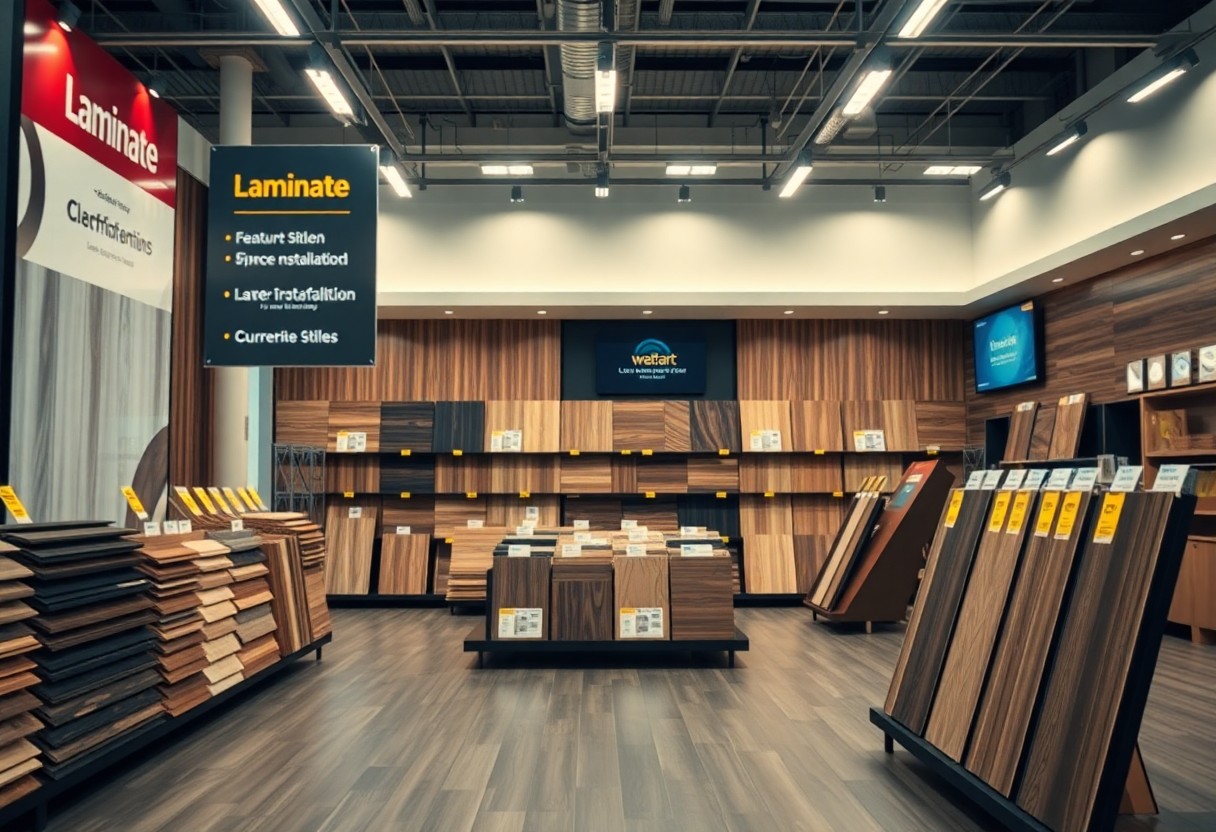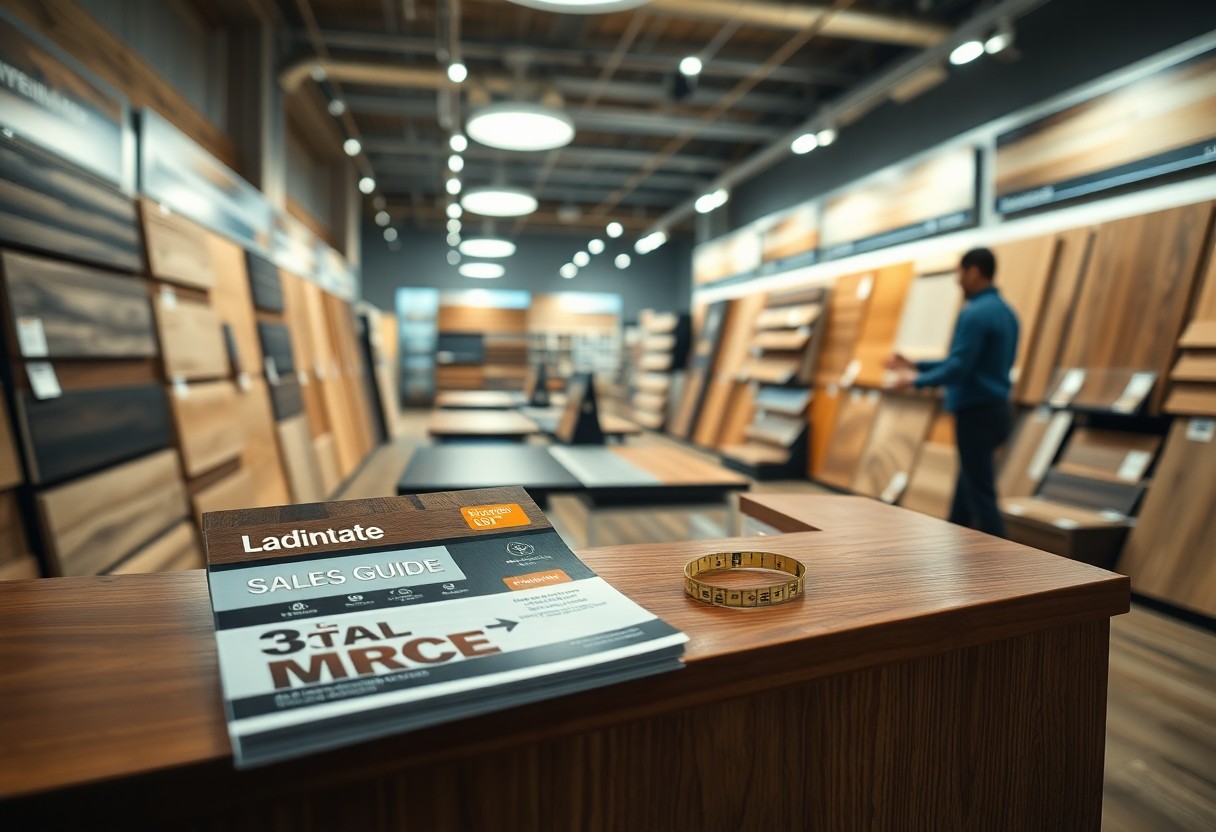There’s a lot to consider when you begin on laminate flooring shopping, especially during a sale. To make the best choice for your home, you need to focus on factors like durability, style, and cost. In this guide, you’ll learn how to assess different products, ensuring that you invest in flooring that meets your aesthetic and practical needs while taking advantage of the best deals available. Your informed decisions will lead to a satisfied purchase that enhances your living space.
Types of Laminate Flooring
Choosing the right type of laminate flooring is important for your project. Various types suit different needs and aesthetics, from aesthetic appeal to durability.
- High-Pressure Laminate
- Direct-Lamination
- Water-Resistant Options
- Thickness Variations
- Surface Finishes
The right choice can enhance your space while meeting functional requirements.
| Type | Description |
|---|---|
| High-Pressure Laminate | Sturdy, durable, and typically used in commercial settings. |
| Direct-Lamination | Cost-effective, suitable for residential use, simpler installation. |
| Water-Resistant Options | Designed to withstand moisture, ideal for kitchens and bathrooms. |
| Thickness Variations | Ranges from 6mm to 12mm, impacting sound and feel underfoot. |
| Surface Finishes | Variety of textures, including matte and gloss, for different looks. |
High-Pressure Laminate
High-pressure laminate (HPL) is known for its durability and is widely used in high-traffic areas. It is created under extreme pressure, making it resistant to scratches and impacts.
Direct-Lamination
Direct-lamination is a more budget-friendly laminate flooring option that combines core materials with a laminate surface layer, simplifying the manufacturing process.
This type is typically easier to install, appealing to DIY enthusiasts and those looking for straightforward home improvement solutions. You will find it less costly than HPL yet still delivers adequate durability for residential use.
Water-Resistant Options
Water-resistant laminate flooring is engineered to hold up against spills and humidity, making it an excellent choice for moisture-prone areas.
This innovation involves special core materials and a sealed surface to mitigate water damage. Ideal for kitchens and bathrooms, these floors allow you to enjoy the aesthetics of laminate without the worry of water infiltration affecting your flooring investment.
Factors to Consider Before Buying
- Purpose of the flooring area
- Foot traffic levels
- Moisture exposure
- Installation method
- Warranty and brand reliability
After evaluating these factors, you can make an informed decision tailored to your specific needs.
Thickness and Durability
Laminate flooring typically ranges from 6mm to 12mm in thickness. Thicker planks often provide better durability and comfort underfoot. If your space sees high traffic or if you have pets, opting for a thicker surface will enhance longevity and reduce wear and tear over time.
AC Rating and Traffic Type
The Abrasion Class (AC) rating indicates the floor’s durability. Ratings range from AC1 (light residential use) to AC5 (heavy commercial use). For residential spaces, an AC3 rating is generally sufficient for moderate traffic. For homes with high foot traffic or commercial areas, consider AC4 and AC5 rated options.
Choosing the right AC rating is key to ensuring your laminate flooring stands up to everyday use. AC1 and AC2 are suitable for bedrooms and low-traffic areas, while AC3 is ideal for living rooms and dining areas. If you have a busy household, opt for AC4 or AC5 to prevent premature wear, making it a sound investment for longevity.
Styles and Colors Available
Laminate flooring is available in a wide variety of styles and colors, mimicking hardwood, stone, or tile. You can choose from traditional oak to modern grey tones, ensuring it complements your interior design. The vast range allows for creativity in transforming your space.
The abundance of styles and colors in laminate flooring means you can easily find something that suits your taste and home décor. Whether you’re after a rustic vibe with distressed finishes or a sleek, contemporary look with high-gloss surfaces, there’s a laminate option to fit your vision. Customizing your space has never been easier, as you can mix and match patterns to create a unique aesthetic.
Pros and Cons of Laminate Flooring
| Pros | Cons |
|---|---|
| Cost-effective compared to hardwood | Less durable than hardwood |
| Easy installation | Can be damaged by excess moisture |
| Variety of styles and finishes | Limited refinishing options |
| Low maintenance required | Can feel less authentic underfoot |
| Good resistance to fading | Impacts resale value |
Advantages
Laminate flooring offers significant advantages, particularly in affordability and convenience. With its cost-effective price point, it allows you to achieve the look of hardwood or tile without the associated expenses. You also benefit from easy installation, often compatible with do-it-yourself techniques, and a diverse range of styles tailored to fit your aesthetic. Maintenance is straightforward, requiring nothing more than regular sweeping and occasional damp mopping.
Disadvantages
Despite the benefits, laminate flooring does come with some drawbacks. One primary concern is its susceptibility to moisture damage, making it unsuitable for high-humidity areas like bathrooms. Additionally, while laminate imitates the appearance of wood, it lacks authenticity in texture and sound. You can’t refinish laminate, limiting its lifespan compared to genuine hardwood. These factors can also influence potential resale value, which may not be as favorable as solid wood options.
Furthermore, even though laminate has a protective layer, it can still get scratched or dented more easily than hardwood. If you have pets or a bustling household, this fragility might result in visible wear over time. Additionally, the sound underfoot can be less appealing, often producing a hollow echo compared to solid flooring options. Keep these points in mind as you weigh your choices.

Tips for Shopping for Laminate Flooring
When shopping for laminate flooring, keep the following tips in mind to make an informed decision:
- Set a clear budget before browsing options.
- Consider the durability required for your space.
- Examine samples in your home lighting for color accuracy.
- Investigate the installation process—DIY or professional?
- Look for sales or package deals that include padding or accessories.
Knowing your priorities will help simplify the shopping experience.
Budgeting and Pricing
Establishing a budget for your laminate flooring is vital. Prices typically range from $1 to $5 per square foot, depending on the quality and style you choose. Factor in additional costs like underlayment, installation, and any required accessories. It’s wise to add a buffer to your budget for unexpected expenses that may arise during installation.
Researching Brands and Warranties
Understanding the brands and their warranties can significantly impact your purchase. Look for well-known manufacturers with positive reviews, as they often provide superior quality flooring options. Most reputable brands offer warranties ranging from 10 years to a lifetime, covering issues like wear and staining. Pay attention to the fine print to know exactly what is covered.
Dig deeper into brand reputation by checking customer reviews and expert ratings. Research shows that top brands like Pergo and Mohawk often surpass others in performance and satisfaction. A strong warranty can be a sign of a reliable product; for instance, a 25-year residential warranty on laminate flooring indicates high confidence in durability. Additionally, consider the type of warranty, whether it covers only the surface layer or includes overall product integrity. This research will help you select a flooring brand that aligns with your needs and expectations.
Step-by-Step Buying Process
| Steps | Description |
|---|---|
| 1. Assess Your Needs | Determine the style, durability, and budget for your laminate flooring. |
| 2. Measure Your Space | Accurately measure the area where you plan to install the flooring. |
| 3. Shop Around | Visit multiple retailers to compare prices and quality. |
| 4. Request Samples | Obtain samples to view flooring options in your space’s lighting. |
| 5. Check Installation Options | Decide whether to hire a professional or opt for DIY installation. |
Measuring Your Space
Start by measuring the length and width of each room where you’ll install laminate flooring. Multiply these dimensions to determine the square footage, adding 10% for waste due to cuts and mistakes. Take into account any alcoves, closets, and hallways as these can affect how much flooring you need to purchase. Accurate measurements ensure you buy the correct amount and avoid last-minute trips to the store.
Comparing Samples and Shows
To choose the best laminate flooring, comparing samples in person is vital. Visit showrooms to see how different styles look under various lighting conditions. It’s helpful to bring home samples to evaluate how they match your existing decor. Pay attention to texture, color, and finish, ensuring they align with your vision for the space.
| Aspects to Consider | Details |
|---|---|
| Texture | Select a texture that complements your room’s style, such as smooth or embossed. |
| Color | Choose colors that enhance your space—lighter shades can make rooms feel larger. |
| Finish | Consider finishes like matte or gloss; gloss can reflect light, while matte adds warmth. |
| Brand Reputation | Research brands for durability and warranty options to ensure a quality purchase. |
Installation Considerations
Concerning laminate flooring installation, you must weigh factors like your skill level, the complexity of the job, and the time you can dedicate. This involves assessing whether you’ll tackle the project yourself or hire a professional. If you attempt a DIY installation, you should be well-prepared, as any mistakes can lead to costly repairs or replacements later.
DIY or Professional Installation
Choosing between DIY and professional installation hinges on your confidence with tools and home improvement projects. If you have experience with similar tasks and access to the right resources, a DIY approach can save you money. However, if you’re uncertain or short on time, hiring professionals ensures a smoother, more precise installation.
Tools and Materials Needed
For a successful laminate flooring installation, you’ll need specific tools and materials, including a saw for cutting planks, a tapping block for securing boards, and a moisture barrier if installing over concrete. You may also require spacers, a hammer, and a measuring tape to ensure accurate placement and alignment.
Gathering the right tools and materials is vital for a successful installation. A circular saw or miter saw will allow you to cut the laminate planks to fit your space, while a tapping block and pull bar help you achieve snug seams without damaging the boards. Don’t overlook the importance of a moisture barrier, especially in areas prone to humidity, as it protects your laminate from warping. Additionally, accumulate spacers and a measuring tape to maintain consistent expansion gaps around your room’s perimeter, ensuring durability over time.
Conclusion
With this in mind, as you navigate your laminate flooring purchase, ensure you evaluate quality, style, and budget. Consider factors such as durability, thickness, and warranty to suit your lifestyle and aesthetic preferences. Take your time comparing options and read reviews to make an informed choice that enhances your space while offering lasting value. Ultimately, your satisfaction hinges on selecting the right laminate flooring that aligns with your needs and vision for your home.





